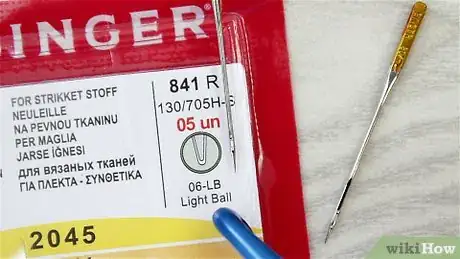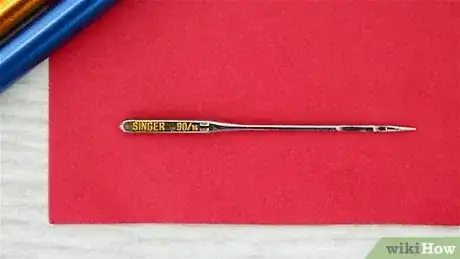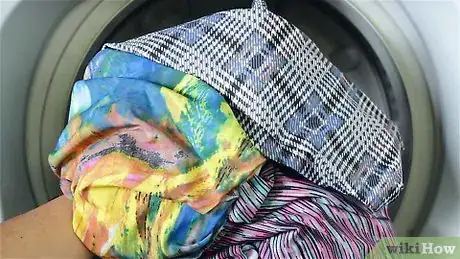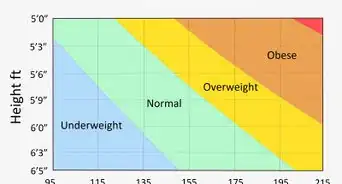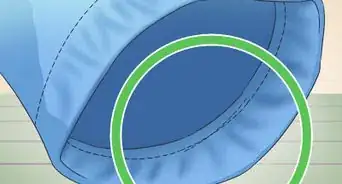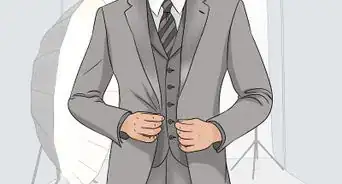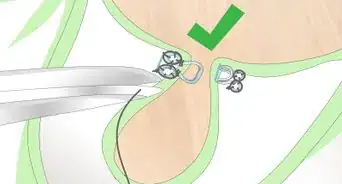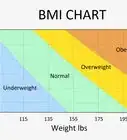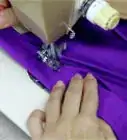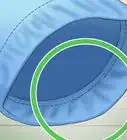This article was co-authored by Korri Burton-Universe. Korri Burton-Universe is a Professional Tailor and the Owner of Uncommon Closet, a custom clothing and tailor resource for the LGBTQIA+ community and those with body types often overlooked by major clothing chains and shops. Korri specializes in custom clothing, tailoring services, and wedding clothes for people of all identities, genders, races, and sizes. Uncommon Closet creates a safe space for people to find or make outfits that make them feel safe and powerful.
There are 10 references cited in this article, which can be found at the bottom of the page.
This article has been viewed 39,720 times.
Stretchy fabrics create comfortable, fitted garments, so they are an excellent choice for many sewing projects. However, stretchy fabrics can be difficult to work with because they are so flexible, and some stretchy fabrics are also slippery. To ensure that you get the best possible results when sewing stretchy fabrics, choose an appropriate sewing machine needle, select settings meant for stretchy fabric on your sewing machine, and use some special techniques for working with stretchy fabric.
Steps
Choosing Your Sewing Machine Needle
-
1Opt for a ballpoint needle for loosely-woven knits. A ballpoint needle has a rounded tip that will go in between the knit fibers rather than piercing through them.[1] If you are worried about damaging the stretch fabric you are using, then choose a ballpoint needle.[2]
- Choose a fine (thin) needle for tightly woven knits and a thick needle for loosely woven knits. Ballpoint needles come in sizes 10 US (70 European) through 16 US (100 European).[3] A smaller number indicates a finer needle, while a larger number indicates a thicker needle.
-
2Choose a stretch needle for lightweight, tightly-woven knits. If you are working with a lightweight, tightly-woven fabric such as Lycra, stretch silk jersey, or lightweight faux suede, then a stretch needle will provide the best results. This type of needle helps to avoid skipped stitches on more delicate stretchy fabrics.[4]
- Select a fine (thin) needle for tightly-woven fabrics and a thick needle for loosely-woven fabrics. Stretch needles come in sizes 11 US (75 European) through 14 US (90 European).[5]
Advertisement -
3Use a universal needle if you need a special size. Universal needles come in a wider range of sizes than other types of sewing machine needles. If you need a sewing machine needle that is extra fine (lower number needle size) or a needle that is extra thick (higher number needle size) and it is not available in a specialty needle, then you may have to get a universal needle.[6]
- Universal needles range in size from US size 8 (European 60) to US size 19 (European 120).[7] Choose a mid-range sized needle, such as a 14 US (90 European), if you are unsure of what size you need for your fabric.
-
4Install a double needle for sewing zigzag hems. To get a professional looking finish on hems, you might consider purchasing a double needle to use with the zigzag stitch setting on your machine. This type of needle will create a double zigzag stitch along the hem that is secure and attractive looking.[8]
- Check your sewing machine’s manual to ensure that it can accommodate a double needle and for instructions on how to install a double needle.
Selecting a Stitch Setting on Your Sewing Machine
-
1Baste before sewing a permanent stitch to prevent mistakes. Baste stitching is when you sew a temporary stitch over a seam or hem to avoid making a mistake with the permanent stitch. Select your sewing machine’s baste stitch setting or set the straight stitch to the longest length, and then sew the areas of the stretch fabric you want to secure.[9] If they do not look right to you, then you can simply pull the end of the baste stitch thread to remove it from the fabric and try again.[10]
- Since stretchy fabrics can be difficult to work with, sewing a baste stitch first is recommended, but it is optional.
-
2Select the stretch stitch setting on your machine if it has one. The stretch stitch setting will provide the best results since it is meant for use with stretchy fabrics.[11] However, not all machines have this setting. Check to see if your machine does and follow your machine’s instructions for how to set it to the stretch stitch.[12]
- Most modern sewing machines have a stretch stitch setting, but your machine may not have this setting if it is an older model.
- Keep in mind that the stretch stitch setting creates stitches that are very difficult to remove if you make a mistake, so baste first and sew carefully![13]
-
3Use the zigzag or straight stitch as an alternative to the stretch stitch. The zigzag stitch is a good alternative to the stretch stitch since it allows fabrics to stretch easily while keeping the seams and hems secure.[14] The straight stitch may also work for some stretch fabrics, but you might want to test it on a scrap of your stretchy fabric first to be sure.[15]
- Check your sewing machine’s instruction manual for how to set it to the zigzag or straight stitch setting.
-
4Choose an overedge stitch if you are using a serger. When you create 2-thread hems and seams with a serger, the top and bottom threads are secured with loops along the outer edges of the fabric. This type of stitching is known as an overedge stitch and it is a great way to keep your hems and seams stretchy.[16]
- Some more advanced sewing machines might include an overedge stitch setting, so check your sewing machine’s instruction manual if you’d like to try this stitch without a serger.
-
5Select a 2.5 to 3 mm stitch length for all stitch types. A longer stitch length is ideal for stretchy fabric because it creates more slack in the stitching. Select 2.5 for less slack, and 3 for more slack.[17]
- If you have a machine with a digital interface and a stretch stitch setting, then it should automatically adjust the stitch length.
- If you have a machine with dials that requires you to adjust the stitch length manually, then you will need to do this no matter what type of stitch you use.
Using Special Techniques for Stretchy Fabric
-
1Insert ballpoint pins to secure the fabric before you sew. To avoid damaging your fabric, use ballpoint pins to secure seams and hems before you sew. Ballpoint pins go in between the knit fibers of stretchy fabric rather than cutting through them with a sharp tip.[18]
- Make sure to insert pins perpendicular to the hem or seam. This will make it easier to remove the pins before you sew over each section.
-
2Place stabilizing fabric under shoulder seams to prevent stretching. If you are using a stretch fabric for a top, then the weight of the fabric may lead to drooping sleeves and stretched out shoulder seams. To avoid this, you can sew a non-stretchy stabilizing fabric into the shoulder seams. Use a 0.75 in (1.9 cm) piece of lightweight, non-stretch fabric, such as silk organza or cotton, cut to the length you need to cover the seam.[19]
- The stabilizing fabric should be even with the edge of the stretch fabric so that you sew through the stabilizing fabric and stretch fabric at the same time.
- You can purchase special types of fabric for interfacing, such as fusible tricot.[20]
-
3Sew in the least stretchy direction. To reduce your machine’s natural pull on stretchy fabric, place the fabric on the machine so you will be sewing in the direction that has the least stretch. Give your fabric a tug from a few different directions to determine which direction is the least stretchy.[21]
- Keep in mind that some fabrics have the same amount of stretch in all directions, so sewing in the least stretchy direction might not always be possible.
-
4Hold the fabric gently to avoid pulling on it as you sew. Since stretchy fabric can extend far beyond its resting length, it is important to avoid pulling at the fabric when you sew it. Hold the fabric so that it is flat, but not stretched out as you sew. Allow the machine’s feed dogs (the gears at the bottom of the machine) to move the fabric under the presser foot as you gently guide it along.[22]
-
5Put a piece of tissue paper under the fabric if the feed dogs pull on it. If your machine pulls on the fabric or does not move it through efficiently, then you can try placing a piece of tissue paper under the fabric as you sew. Sew the seams and hems through the fabric and tissue paper. Then, tear the tissue paper away from the stitches after you are finished sewing.[23]
- The tissue paper should come off easily because it has been pierced multiple times with the sewing machine needle.
-
6Steam your finished project. Steaming may help to reinvigorate the fabric after you finish sewing it. Use your iron or fabric steamer on the lowest setting to steam the fabric. You can also place a towel or t-shirt over the fabric to help protect it if you are concerned about damaging it with the heat from the steamer.[24]
Preparing Stretchy Fabric for Sewing
-
1Prewash stretchy fabrics before sewing them. There is some debate about whether or not you should prewash stretchy fabrics, so it is up to you. However, if you want to ensure that your fabric will not shrink or fade after the first time you wash it, do a prewash before you sew.[25]
- Follow the laundering instructions for the fabric you are using. In some cases, it may be necessary to dry clean the fabric.
-
2Spray stretchy fabric with a starch spray to prevent curling edges. If your fabric curls along the edges and this is making it hard for you to sew it, then you might want to spray the edges with a starch spray. This will help to keep them stabilized when you sew and then it will wash out the first time you launder your finished project.[26]
-
3Avoid pulling on the fabric when you cut along the edges of a pattern. Whether you choose to insert pins or place paperweights to hold the stretchy fabric in place under your pattern, make sure that you do not pull on it when you cut the fabric. This may affect the fit and look of your finished project.[27]
Expert Q&A
-
QuestionWhat setting should I use for stretchy material?
 Korri Burton-UniverseKorri Burton-Universe is a Professional Tailor and the Owner of Uncommon Closet, a custom clothing and tailor resource for the LGBTQIA+ community and those with body types often overlooked by major clothing chains and shops. Korri specializes in custom clothing, tailoring services, and wedding clothes for people of all identities, genders, races, and sizes. Uncommon Closet creates a safe space for people to find or make outfits that make them feel safe and powerful.
Korri Burton-UniverseKorri Burton-Universe is a Professional Tailor and the Owner of Uncommon Closet, a custom clothing and tailor resource for the LGBTQIA+ community and those with body types often overlooked by major clothing chains and shops. Korri specializes in custom clothing, tailoring services, and wedding clothes for people of all identities, genders, races, and sizes. Uncommon Closet creates a safe space for people to find or make outfits that make them feel safe and powerful.
Professional Tailor You should choose the stretch stitch setting on your machine if it has one.
You should choose the stretch stitch setting on your machine if it has one. -
QuestionWhat stitch should I use on stretchy material?
 Korri Burton-UniverseKorri Burton-Universe is a Professional Tailor and the Owner of Uncommon Closet, a custom clothing and tailor resource for the LGBTQIA+ community and those with body types often overlooked by major clothing chains and shops. Korri specializes in custom clothing, tailoring services, and wedding clothes for people of all identities, genders, races, and sizes. Uncommon Closet creates a safe space for people to find or make outfits that make them feel safe and powerful.
Korri Burton-UniverseKorri Burton-Universe is a Professional Tailor and the Owner of Uncommon Closet, a custom clothing and tailor resource for the LGBTQIA+ community and those with body types often overlooked by major clothing chains and shops. Korri specializes in custom clothing, tailoring services, and wedding clothes for people of all identities, genders, races, and sizes. Uncommon Closet creates a safe space for people to find or make outfits that make them feel safe and powerful.
Professional Tailor Go with a zigzag stitch since it'll give you a strong and attractive-looking seam.
Go with a zigzag stitch since it'll give you a strong and attractive-looking seam. -
QuestionIf I'm sewing leggings into footed tights, how much extra material should I add for the feet?
 T. ChinsenTop AnswererUse a pair of socks with the same fabric weight as the leggings to get an estimate. Most knit fabrics have a horizontal stretch. When purchasing fabric, the toe-to-heel length is the vertical height of the knit fabric.
T. ChinsenTop AnswererUse a pair of socks with the same fabric weight as the leggings to get an estimate. Most knit fabrics have a horizontal stretch. When purchasing fabric, the toe-to-heel length is the vertical height of the knit fabric.
References
- ↑ Korri Burton-Universe. Professional Tailor. Expert Interview. 12 January 2021.
- ↑ https://www.threadsmagazine.com/2008/01/11/tips-and-tricks-for-sewing-with-knits
- ↑ http://www.sewing.org/files/guidelines/22_115_sewing_machine_needle_charts.pdf
- ↑ https://www.threadsmagazine.com/2008/01/11/tips-and-tricks-for-sewing-with-knits
- ↑ http://www.sewing.org/files/guidelines/22_115_sewing_machine_needle_charts.pdf
- ↑ http://www.sewing.org/files/guidelines/22_115_sewing_machine_needle_charts.pdf
- ↑ http://www.sewing.org/files/guidelines/22_115_sewing_machine_needle_charts.pdf
- ↑ https://www.threadsmagazine.com/2008/01/11/tips-and-tricks-for-sewing-with-knits
- ↑ https://www.thesprucecrafts.com/how-to-baste-2977511
- ↑ https://www.thesprucecrafts.com/knits-and-stretchy-fabric-2978470
- ↑ Korri Burton-Universe. Professional Tailor. Expert Interview. 12 January 2021.
- ↑ https://www.thesprucecrafts.com/knits-and-stretchy-fabric-2978470
- ↑ https://www.fabric.com/blog/sewing-with-knits/
- ↑ Korri Burton-Universe. Professional Tailor. Expert Interview. 12 January 2021.
- ↑ https://www.threadsmagazine.com/2008/01/11/tips-and-tricks-for-sewing-with-knits
- ↑ https://www.threadsmagazine.com/2011/12/01/choose-the-right-serger-stitch-for-your-project
- ↑ https://www.threadsmagazine.com/2008/01/11/tips-and-tricks-for-sewing-with-knits
- ↑ https://www.threadsmagazine.com/2008/11/11/a-pin-for-every-purpose
- ↑ https://www.thesprucecrafts.com/knits-and-stretchy-fabric-2978470
- ↑ https://www.threadsmagazine.com/2008/01/11/tips-and-tricks-for-sewing-with-knits
- ↑ https://www.contrado.co.uk/blog/how-to-sew-stretchy-fabric/
- ↑ https://www.thesprucecrafts.com/knits-and-stretchy-fabric-2978470
- ↑ https://www.thesprucecrafts.com/how-to-sew-slippery-fabric-tips-2978437
- ↑ https://www.contrado.co.uk/blog/how-to-sew-stretchy-fabric/
- ↑ https://www.contrado.co.uk/blog/how-to-sew-stretchy-fabric/
- ↑ https://www.contrado.co.uk/blog/how-to-sew-stretchy-fabric/
- ↑ https://www.contrado.co.uk/blog/how-to-sew-stretchy-fabric/
About This Article
Stretchy fabrics can be difficult to sew, but you can make the process easier by choosing a proper needle and using specific stitches. If your stretchy fabric is loosely-woven and you’re afraid of damaging it, opt for a ballpoint needle, which has a rounded tip that will go in between the fibers instead of piercing them. For lightweight, tightly-woven fabrics like Lycra, stretch silk jersey, or lightweight faux suede, pick a stretch needle. Once you have the right needle for your fabric, make sure to baste, or sew a temporary stitch, using your sewing machine’s longest length setting. If your machine has a stretch stitch setting, pick that for your project. Otherwise, use a zigzag or straight stitch, as these will give your fabric the room to stretch. For more help, like how to prepare stretchy fabric for sewing, read on.
